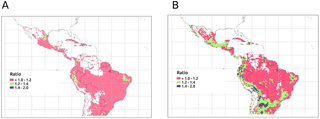PLOS Neglected Tropical Diseases ( IF 3.4 ) Pub Date : 2017-11-01 , DOI: 10.1371/journal.pntd.0006007 Felipe J. Colón-González , Carlos A. Peres , Christine Steiner São Bernardo , Paul R. Hunter , Iain R. Lake

|
Background
Zika is one of the most challenging emergent vector-borne diseases, yet its future public health impact remains unclear. Zika was of little public health concern until recent reports of its association with congenital syndromes. By 3 August 2017 ∼217,000 Zika cases and ∼3,400 cases of associated congenital syndrome were reported in Latin America and the Caribbean. Some modelling exercises suggest that Zika virus infection could become endemic in agreement with recent declarations from the The World Health Organisation.
Methodology/Principal findings
We produced high-resolution spatially-explicit projections of Zika cases, associated congenital syndromes and monetary costs for Latin America and the Caribbean now that the epidemic phase of the disease appears to be over. In contrast to previous studies which have adopted a modelling approach to map Zika potential, we project case numbers using a statistical approach based upon reported dengue case data as a Zika surrogate. Our results indicate that ∼12.3 (0.7–162.3) million Zika cases could be expected across Latin America and the Caribbean every year, leading to ∼64.4 (0.2–5159.3) thousand cases of Guillain-Barré syndrome and ∼4.7 (0.0–116.3) thousand cases of microcephaly. The economic burden of these neurological sequelae are estimated to be USD ∼2.3 (USD 0–159.3) billion per annum.
Conclusions/Significance
Zika is likely to have significant public health consequences across Latin America and the Caribbean in years to come. Our projections inform regional and federal health authorities, offering an opportunity to adapt to this public health challenge.
中文翻译:

流行之后:寨卡病毒在拉丁美洲和加勒比地区的预测
背景
寨卡病毒是最具挑战性的新兴媒介传播疾病之一,但其未来对公共卫生的影响仍不清楚。在最近有报道称其与先天性综合症有关之前,Zika很少关注公共卫生。截至2017年8月3日,拉丁美洲和加勒比地区报告了约217,000例Zika病例和约3,400例相关的先天性综合征。一些建模练习表明,与世界卫生组织最近的声明一致,寨卡病毒感染可能成为地方病。
方法/主要发现
由于该疾病的流行期似乎已经结束,因此我们对拉丁美洲和加勒比海地区的寨卡病例,相关的先天性综合症和金钱成本进行了高分辨率的空间明晰预测。与以前采用建模方法绘制Zika潜力的研究相反,我们使用统计方法根据报告的登革热病例数据作为Zika替代品来预测病例数。我们的结果表明,拉丁美洲和加勒比地区每年预计会有12.3(0.7–162.3)例寨卡病例,导致约64.4(0.2–5159.3)例吉兰-巴雷综合症和4.7(0.0–116.3)例千例小头畸形。这些神经系统后遗症的经济负担每年约为2.3亿美元(0-1593亿美元)。
结论/意义
在未来的几年中,寨卡病毒可能会对整个拉丁美洲和加勒比地区产生重大的公共卫生后果。我们的预测为区域和联邦卫生当局提供了信息,为适应这一公共卫生挑战提供了机会。











































 京公网安备 11010802027423号
京公网安备 11010802027423号